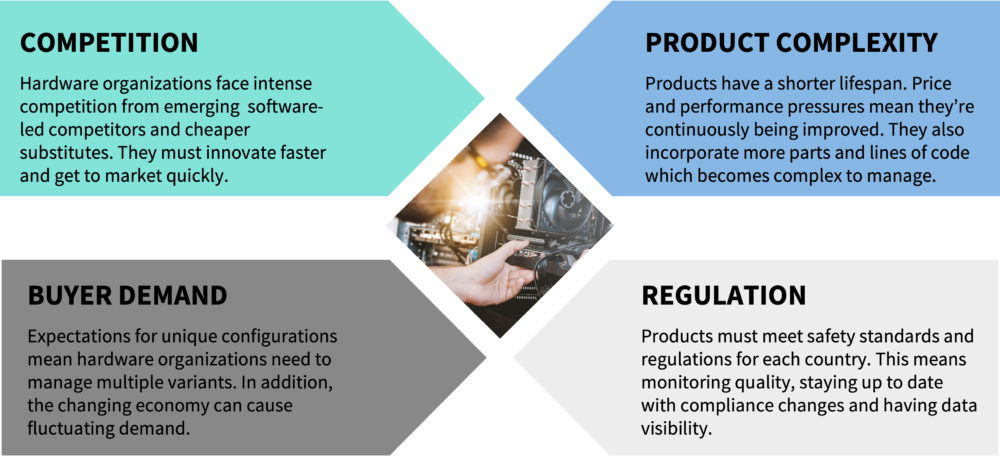
Modernizing closed loop quality by connecting PLM to QMS
Rob Markevics, VP of Sales, Duro
In September, Rob Markevics presented on closed loop quality at Intellect Innovate. You can rewatch his presentation here. In this blog he recaps some of the key points from the talk, discussing why it’s important to build quality early into the product development lifecycle. He covers challenges with getting products to market quickly and shares his thoughts on why quality and PLM go hand in hand.
Manufacturers face challenges with increasing product complexity while getting products to market faster
Competition and buyer demand are pushing manufacturers to get products to market faster. They also face challenges with products becoming increasingly complex and regulations getting stricter.
Other market dynamics that are influencing organizations include: growth of electronics and software and evolution of computational power. Hardware companies like Apple and Tesla are becoming software-centric, and software companies like Google are becoming hardware-centric. All this means that products are getting more complex. It’s hard to imagine but a Ford F-150 pick-up truck now has 150 million lines of code compared to only seven million lines of code for a Boeing Dreamliner, as discussed in Digital Trend’s article, ‘Ford’s new GT has more lines of code than a Boeing jet airliner’. Then there’s the IoT aspect; your refrigerator, garage door opener, a pacemaker, or virtually anything can be connected to the web, which calls for added electronics and software content.

With so much change affecting the hardware industry, we’re starting to see supply chain challenges. A notable example is the chip shortages that started in 2020 and stalled the automotive industry.
The bottom line is that companies are continuously forced to do more with less. In order to accomplish this, we have to understand the values and strategies of modern agile hardware teams.
Engineers need tools that support agile development
Traditional hardware teams and modern agile hardware teams function very differently. Within traditional hardware organizations, mechanical, software, and electrical teams and platforms were siloed. They followed rigid processes and traditional design cycles. Today’s hardware teams must be agile and flexible to keep up with demand and beat the competition. They must be intuitive and collaborative to support quick and informed decisions by the various stakeholders involved in the design process. This includes mechanical, electrical, and software design teams, as well as quality of manufacturing.
To meet the increasing demand to iterate products and get to market quickly, they must be able to easily share data. Additionally, software must be connected, easy to use, and incorporate automation to speed up processes.
From a Duro perspective, we recognize that traditional processes and the related software systems that were historically established to support mechanical-centric development processes simply aren’t good enough anymore. Duro’s cloud-native PLM was uniquely created to address these challenges. For example, it brings the sourcing process upstream in the design process. Integrations to parts catalogs give designers real-time visibility into cost, weight, and availability and lead-time information that support informed upstream design decisions.
Duro is also unique in that it’s a cloud-based PLM with a robust API that supports data sharing not only across the different stakeholders, but across the entire ecosystem. It provides a way to bring data from every lifecycle stage into a central PLM hub which is vital for ensuring quality remains consistent as products are designed.
Without PLM quality suffers and costs can escalate
The product development lifecycle starts with requirements management. There are software solutions that customers use to define products such as the force a product must endure, the temperatures it must withstand, the weight, the cost, and the dimensional characteristics. There are synergies with PLM that ensure these requirements are adhered to or not compromised during design.
At a high-level, PLM places value on the disposition of the design, whereas QMS tools, like Intellect, manage quality events, root cause evaluations, and assurances that quality issues are not repeatable. The synergy dynamic shows that PLM needs to be aware and track quality issues because:
- it may require a design change, and
- we want to capture the history so that with the next generation design the issue doesn’t re-surface.
“The goal is to catch quality issues in a digital environment up-stream, as opposed to when a product gets launched. Or worse yet, when it is out in the field when the cost of a recall or damage to the brand could be devastating. This is where closed-loop-quality comes into play.”

Closed loop quality brings everything together
So, what is closed loop quality? Here’s a simple definition from engineering.com:
“Manufacturers now realize that quality control no longer can be siloed in a single department but rather needs to be extended throughout the enterprise. This requires a technology-based enterprise quality management system (EQMS) that enables closed-loop quality, a strategy model in which quality data flows across the functional levels of a manufacturing enterprise.”
Closed loop quality systems have a few key characteristics:
- The notion of quality management spans the entire product lifecycle.
- It involves every discipline or stakeholder.
- Aspects of quality are linked back to the product history and design, which are in PLM.
PLM manages the BOM and all its attribute data during the design phase. PLM cares about managing and tracking changes and the subsequent revisions. QMS cares about non-conformance, complaints, deviations to the product and components and subsequently resolving the quality issue and mitigating risk. The closed loop aspect comes into play when these quality issues are identified and fed back to PLM to track history and manage change. Duro has partnered with Intellect QMS to enable that closed loop quality.
Quality must be extended throughout the enterprise
The notion of closed loop quality is not necessarily new. But it requires a best-of-breed ecosystem approach, so engineers can maintain agility in product development while still ensuring the closed-loop-connection.
In all your actions, process, planning and system selection, make sure you do things that will enable you to shift the cost of quality left. Prepare your best-of-breed ecosystem strategy. When looking at systems, make sure that you think about the big picture. You want them to be modular, nimble, and affordable.
Interested to learn more about how Intellect QMS and Duro cloud-native PLM work together? Watch Rob’s session from Intellect Innovate.